Two starving juvenile Indian Vultures rescued in 3 days, presence of species in region alerts Forest Deptt
| Date :06-Aug-2023 |

One of the rescued juvenile Long-Billed Vultures recuperating at Transit Treatment Centre.
Staff Reporter :
Vanished from Gondia and Nagpur districts decades ago, this vulture species is listed as ‘Critically Endangered’ by IUCN
Rescue of two juvenile Long-Billed Vultures (Indian Vulture) from Nagpur and Gondia districts, in last three days, has raised many questions in the Forest Department.
Three days ago, a veterinary doctor sighted a juvenile vulture in Aamgaon village of Gondia district. A team of Transit Treatment Centre (TTC), Seminary Hills, Nagpur, rescued the scavenger. The TTC team rescued another vulture on Saturday.
The second vulture was sighted at Gumthala village near Pardi in Nagpur. Both the vultures were starving when the TTC team rescued them.
This vulture species has been listed as ‘Critically Endangered’, which is the highest category of endangerment, by the International Union for Conservation of Nature (IUCN) and World Conservation Union.
Swinging into action, the Forest Department has appealed to the citizens of Nagpur district to inform the Department on helpline number 0712-2515306 in case they sight a vulture in any part of the city.
“Everyone is aware that tiger is an endangered species but this species of vultures is critically endangered and requires
conservation. As the rescued vultures are in starving condition, it is a matter of great concern for us. The Department is taking it seriously,” Dr Bharat Singh Hada, Deputy Conservator of Forest, Nagpur, told The Hitavada.
“Both the vultures were dehydrated due to paucity of food. Both were unable to fly due to weakness. The treatment is under way and as per the blood test report both were found dehydrated but showed no symptoms of poisoning,” said Kundan Hate, ex-Member, State Wildlife Board.
The population of Long-Billed Vultures in Maharashtra is very less.
The vultures mostly reside in Vidarbha region and some other parts of West Maharashtra. Apart from Maharashtra, they also dwell in Madhya Pradesh, South India and some other States. “We will contact with the Madhya Pradesh Forest Department to know sighting of vulture in a starving condition in their State. If they report such cases then it should be addressed on priority basis,” said Hate. “After rescuing the vultures, we found that their weight were just 3.3 kg and 3.6 kg respectively. They are responding to treatment and started consuming food,” added Hate.
According to an wildlife expert, there are just 10-15 Long-Billed Vultures are there in Pench forest of Maharashtra side and half a dozen lives in Gadchiroli.
This species got extinct from Gondia district 10-15 years ago and from Nagpur district it vanished 50 years back. “The rescue of these juvenile vultures indicates presence of the species in Gondia district which require a proper study by experts,” said the wildlife expert. More than 97 per cent of Indian Vulture died out between 1993 and 2007 due to diclofenac, a veterinary drug used for pain management in livestock. As per the experts this medicine is the main cause of the near wipe-out of vultures, who were eating such carrion and then suffering kidney failure almost within 24 hours. Thereafter, diclofenac was banned for veterinary use in India and Nepal in 2006 and in Bangladesh in 2010. Despite this ban, human-use diclofenac was being use in veterinary treatments.